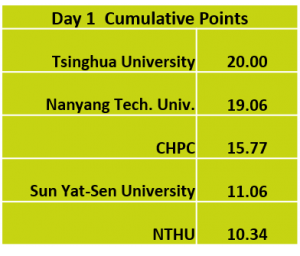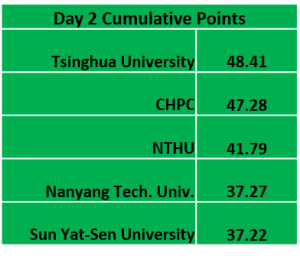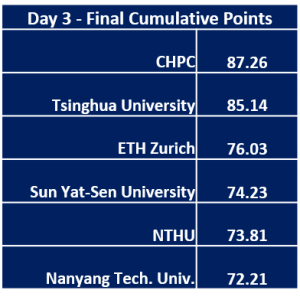The ISC19 Student Cluster Competition in Frankfurt, Germany had one of the closest and most exciting finishes in cluster competition history. The overall winner was decided by just over two percentage points and the margin between third and fourth place was less than a single percentage point.
Let’s go through a day-by-day summary of the action and see who won and how.
Day 1: Benchmarks
The first day saw the competitors run LINPACK, HPCC, and HPCG. Only HPCC and HPCG count towards the overall championship score, while their LINPACK score is used to determine the Highest LINPACK Award winner.
 Tsinghua University carved out an early lead by notching a perfect two-for-two on HPCG and HPCC. Each benchmark is worth a maximum of 10 points , so Tsinghua takes 20 points on the first day.
Tsinghua University carved out an early lead by notching a perfect two-for-two on HPCG and HPCC. Each benchmark is worth a maximum of 10 points , so Tsinghua takes 20 points on the first day.
Under the ISC scoring system, the winner takes all the possible points for each task, with the other teams getting proportional points based on how well they did vs. the winning score.
Tsinghua narrowly won HPCG, topping Nanyang Tech by less than four percentage points. They built on their HPCG success with their field leading HPCC score, which topped Nanyang by 6%.
CHPC hung in there by taking third place, while Sun Yat-Sen took fourth place. In terms of points, Tsinghua takes Day 1 with 20 points, with Nanyang fractionally behind.
Day 2: Applications Flip the Script
On Day 2, the competitors stared down their first set of HPC applications. The menu for the day was CP2K, Swift, and PENNANT.
 Tsinghua held on to their lead by turning in solid scores on all the applications. They nabbed second place on CP2K, third on Swift, and fifth on PENNANT.
Tsinghua held on to their lead by turning in solid scores on all the applications. They nabbed second place on CP2K, third on Swift, and fifth on PENNANT.
The real story on Day 2 was the moves made by CHPC and NTHU. While CHPC only scored seventh on CH2K, it didn’t hurt them much because this app was only worth 10% of their overall competition score. They made up for it with a second place on Swift (10%) and a first-place finish on PENNANT – which counts for 15% in the overall score.
NTHU earned a full ten-point winners share on CP2K, which gave them some momentum. They followed it up by winning Swift, giving them an additional ten points. They faded a bit on PENNANT, only taking down sixth place. Nanyang and Sun Yat-Sen were deadlocked in fourth place, with only five one hundredths of a point separating them.
While it might seem like Tsinghua and CHPC have insurmountable leads, we need to realize that only just over half of the possible points have been handed out so far – there are still 45 potential points to be earned. In short, it’s still anyone’s game, although the teams with scores under 40 have their work cut out for them.
Day 3: The Thrilling Finish
As the sun rose on Day 3, the entire city was tense – knowing that the results of the ISC19 cluster competition would be revealed that afternoon. The teams had no idea of where they stood on the leaderboard
, so they clustered hard to put up as many points as possible.
 Day 3 was a big day. Between the OpenFOAM application, the AI Challenge, and the interview there were 45 points still to be awarded. Anything could happen. In past competitions, we’ve seen leaders stumble and we’ve also seen teams lagging put together a streak that lands them on the podium. That’s exactly what we’ve seen at ISC19.
Day 3 was a big day. Between the OpenFOAM application, the AI Challenge, and the interview there were 45 points still to be awarded. Anything could happen. In past competitions, we’ve seen leaders stumble and we’ve also seen teams lagging put together a streak that lands them on the podium. That’s exactly what we’ve seen at ISC19.
Tsinghua went into Day 3 with a narrow lead over CHPC. They lost some of their margin when CHPC won OpenFOAM, earning 10 points to Tsinghua’s 9.75 points. At this point, the two teams were nearly tied with Tsinghua (at 58.16%) barely holding off CHPC (with 57.28%). Meanwhile, some of the leaders from Day 2 were showing vulnerabilities with Nanyang, NTHU, and Sun Yat-Sen not posting big scores on OpenFOAM.
The big application of the day, the AI Challenge, was worth a whopping 25 points and would decide the competition. Whoever took the most points on it would probably rule the day.
ETH Zurich parlayed a first-place finish on the AI application into a third-place overall finish – coming out of nowhere to take home the trophy. It’s going to look nice next to their Highest LINPACK Award hardware.
The second-place finisher on the AI Challenge was shocking. Taiwan’s NCKU, with their tiny dual-workstation cluster, amazed everyone by snatching second out of the jaws of their better-equipped rivals. Score one for the underdogs, great job!
Nanyang took third place on the AI app, adding a little over 21 points to their total. EPCC finished fourth, while Sun Yat-Sen took fifth, which was enough to give them the fourth-place finish in the overall competition.
CHPC sealed their win by grabbing the seventh-place position and 20.64 points vs. Tsinghua’s ninth-place finish, which only earned them just over 17 points. While Tsinghua scored a half point better than CHPC on the 10-point interview portion of the competition, it wasn’t quite enough to allow them to overtake CHPC for the win.
With this win, CHPC has now taken home the ISC Overall Championship an astounding four times, pulling even with Tsinghua in number of ISC championships. CHPC also maintained their record of reaching the podium in each of their seven cluster competition outings.
Tsinghua adds another Silver trophy to their overcrowded trophy case and newcomer ETH Zurich can now place two cluster competition trophies (LINPACK and Bronze) on their shelf.
If you’d like to see the awards announcement, check out the lavish two-camera coverage of the ISC’19 Cluster Competition Awards Ceremony below.
Whew! What a competition! We’re almost finished with our coverage of the ISC19 Student Cluster Competition. We will be rolling out a new analysis of how the teams fared on tuning and optimization in our final article.
If you want to see how our student teams rank in worldwide cluster competitions, take a look at the new Student Cluster Competition Leadership List.
Posted In: Latest News, ISC 2019 Frankfurt
